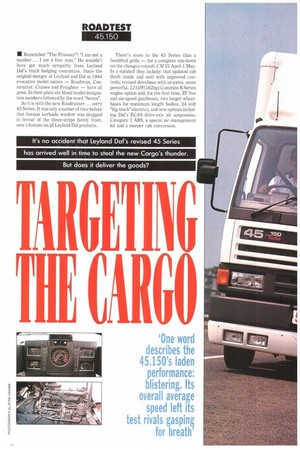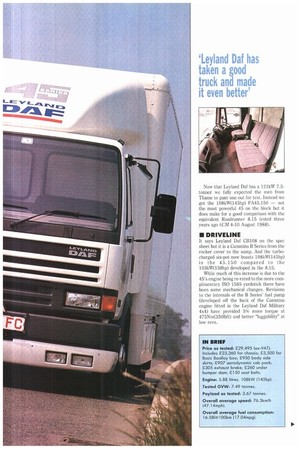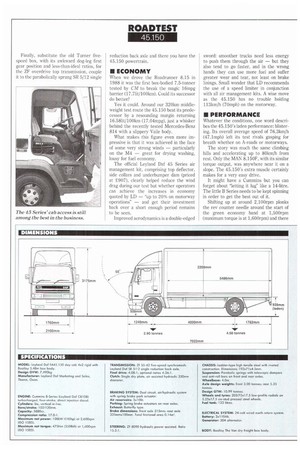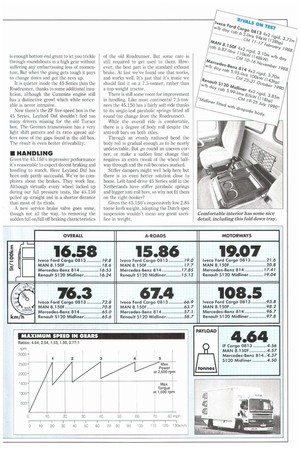It's no accident that Leyland Dal's revised 45 Series has
Page 24

Page 25

Page 26

Page 27

Page 28

If you've noticed an error in this article please click here to report it so we can fix it.
arrived well in time to steal the new Cargo's thunder. But does it deliver the goods?
• Remember The Prisoner"? "I am not a number... I am a free man." He wouldn't have got much sympathy from Leyland Dais truck badging committee. Since the original merger of Leyland and Daf in 1984 evocative model names — Roadtrain, Constructor, Cruiser and Freighter — have all gone. In their place are bland model designation numbers followed by the word "Series".
So it is with the new Roadrunner. ... sorry 45 Series. It was only a matter of time before that famous kerbside window was dropped in favour of the three-stripe family front, now a feature on all Leyland Daf products. There's more to the 45 Series than a facelifted grille — for a complete run-down on the changes consult CM 25 April-1 May. In a nutshell they include: that updated cab (both inside and out) with improved controls; revised drivelines with an extra, more powerful, 121kW(162hp) Cummins B Series engine option and, for the first time, ZF five and six-speed gearboxes, two longer wheelbases for maximum length bodies, 24 volt big truck" electrics; and new options including Dais ECAS drive-axle air suspension, Category 1 ABS, a special air management kit and a sleeper cab conversion.
Now that Leyland Daf has a 121kW 7.5tonner we fully expected the men from Thame to punt one out for test. Instead we got the 108kW(145hp) FA45.150 — not the most powerful 45 on the block but it does make for a good comparison with the equivalent Roadrunner 8.15 tested three years ago (CM 4-10 August 1988).
• DRIVELINE
It says Levland Dal C8108 on the spec sheet but it is a Cummins B Series from the rocker cover to the sump. And the turbocharged six-pot now boasts 108kW(145hp) in the 45.150 compared to the 103kW(138hp) developed in the 8.15.
While much of this increase is due to the 45's engine being re-rated to the more complimentary ISO 1585 yardstick there have been some mechanical changes. Revisions to the internals of the B Series fuel pump (developed off the back of the Cummins engine fitted in the Leyland Daf Military 4x4) have provided 5% more torque at 475Nm(350lbft) and better "luggability" at low revs. Finally, substitute the old Turner fivespeed box, with its awkward dog-leg first gear position and less-than-ideal ratios, for the ZF overdrive top transmission, couple it to the parabolically sprung SR 5/12 single reduction back axle and there you have the 45.150 powertrain.
• ECONOMY
When we drove the Roadrunner 8.15 in 1988 it was the first box-bodied 7.5-tonner tested by CM to break the magic 16mpg barrier (17.71it/100km). Could its successor do better?
Yes it could. Around our 320km middleweight test route the 45.150 beat its predecessor by a resounding margin returning 16.581a/100km (17.04mpg), just a whisker behind the recently tested Mercedes-Benz 814 with a slippery Vaile body.
What makes this figure even more impressive is that it was achieved in the face of some very strong winds — particularly on the M4 — great for drying washing, lousy for fuel economy.
The official Leyland Daf 45 Series air management kit, comprising top deflector, side collars and underbumper dam (priced at .007), clearly helped reduce the wind drag during our test but whether operators can achieve the increases in economy quoted by LD — "up to 20% on motorway operations" — and get their investment back over a short enough period remains to be seen.
Improved aerodynamics is a double-edged sword: smoother trucks need less energy to push them through the air — but they also tend to go faster, and in the wrong hands they can use more fuel and suffer greater wear and tear, not least on brake linings. Small wonder that LD recommends the use of a speed limiter in conjunction with all air management kits. A wise move as the 45.150 has no trouble holding 113km/h (70mph) on the motorway.
• PERFORMANCE
Whatever the conditions, one word describes the 45.150's laden performance: blistering. Its overall average speed of 76.3km/h (47.1mph) left its test rivals gasping for breath whether on A-roads or motorways.
The story was much the same climbing hills and accelerating up to 80krn/h from rest. Only the MAN 8.150F, with its similar torque output, was anywhere near it on a slope. The 45.150's extra muscle certainly makes for a very easy drive.
It might have a Cummins but you can forget about "letting it lug" like a 14-litre. The little B Series needs to be kept spinning in order to get the best out of it.
Shifting up at around 2,100rpm plonks the rev counter needle around the start of the green economy band at 1,500rpm (maximum torque is at 1,600rpm) and there
is enough bottom end grunt to let you trickle through roundabouts in a high gear without suffering any embarrassing loss of momentum. But when the going gets tough it pays to change down and get the revs up.
It is quieter inside the 45 Series than the Roadrunner, thanks to some additional insulation, although the Cummins engine still has a distinctive growl which while noticeable is never intrusive.
Now there's the 2F five-speed box in the 45 Series, Leyland Daf shouldn't find too many drivers missing for the old Turner box. The German transmission has a very light shift pattern and its ratio spread suffers none of the gaps found in the old box. The result is even better driveability, • HANDLING
Given the 45.150's impressive performance its reasonable to expect decent braking and handling to match. Here Leyland Daf has been only partly successful. We've no complaints about the brakes. They work fine. Although virtually every wheel locked up during our full pressure tests, the 45.150 pulled up straight and in a shorter distance than most of its rivals.
A new service brake valve goes some, though not all the way, to removing the sudden full on/full off braking characteristics of the old Roadrunner. But some care is still required to get used to them. However, the best part is the standard exhaust brake. At last we've found one that works, and works well. It's just that it's ironic we should find it on a 7.5-tonner, rather than a top-weight tractor.
There is still some room for improvement in handling. Like most continental 7.5-tonners the 45.150 has a fairly soft ride thanks to its single-leaf parabolic springs fitted all round (no change from the Roadrunner).
While the overall ride is comfortable, there is a degree of body roll despite the anti-roll bars on both axles.
Through an evenly radiused bend the body roil is gradual enough as to be nearly undetectable. But go round an uneven corner, or make a sudden lane change that requires an extra tweak of the wheel halfway through and the roll becomes marked.
Stiffer dampers might well help here but there is an even better solution close to home. Left-hand-drive 45 Series sold in the Netherlands have stiffer parabolic springs and bigger anti-roll bars, so why not fit them on the right-hooker?
Given the 45.150's impressively low 2.85 tonne kerb weight, adopting the Dutch spec suspension wouldn't mean any great sacrifice in weight.
• CAB COMFORT
Access to the 45 Series cab is no different to the old Roadrunner, in other words very good. The deep first step, wide door aperture and two well-placed grab handles make entry and exit a doddle.
Now that the famous Roadrunner lower front window has gone there is extra storage space on the left-hand side of the dash. Although the deeper facia intrudes more into the passenger footwell, cross-cab movement has not been compromised.
In addition to the deep pocket in the dash there is plenty of other stowage space including under the passenger bench seat and in a pocket and net on the rear bulkhead.
The revised grey interior trim is easy on the eye, but a darker shade of fabric on the seats would hide the dirt better. The rubber floor covering is practical for muddy boots, however, and easy to sweep out.
The standard lsri fixed seat (an air sprung seat is optional) provides plenty of comfort and the adjustable steering column allows just about every driving position to be accommodated. The ZF steering has good feed back. The driver's lot has also been made easier with a cable system replacing the old Roadrunner rod controlled throttle pedal, and the clutch effort has been reduced as well.
In the past we've criticised the Roadrunner for its rather tacky main instrument panel. The message has finally got through. The 45 Series sports a much improved main binnacle although the plastic windows over the gauges are still rather cheap looking.
Nothing has changed so far as servicing and maintenance are concerned. Despite gaining some extra insulation the B Series is easily accessible. All daily checks can be done without tilting the cab.
The 45 Series' flat-topped chassis and body attachment mounts should please most bodybuilders. New 5.1 and 5.5m wheelbases allow a true "24ft" (7.3m) body to be fitted (the 5.5m will do it with a sleeper cab).
• SUMMARY
Leyland Daf has taken a good truck and made it even better. Dri the balance sheet there's plenty of pros and very few cons. The 45.150 is comfortable, easy-to-drive, quick to stop and powered by an engine with a performance punch that any 7.5 tonne driver will appreciate and with the kind of economy that will keep his boss happy. And when it comes to body/payload allowances the comparison chart says it all.
Nothing is ever perfect. There is still room for some improvement, or at least further attention to detail, not least on the 45.150's roll characteristics and the dash. But these are minor minuses which many rivals would be happy to live with.
The 45 certainly isn't the cheapest deal on wheels and the price has recently gone up. At £23,360 it's more expensive than the G90 MAN (120,190), Mercedes 814 (E21,290), Renault Midliner S140 (£21,500) and AWD TL8.14 (Z21,045), The nearest to it is the soon-to-be-replaced 0815 Cargo at £23,080.
But in a world where you only get what you pay for, the 45 Series justifies its premium price.
Three years ago we said: In the right hands [the Roadrunner] could prove to be the vehicle that finally eases lveco Ford's stranglehold on the 7.5 tonne market". Having driven the 45.150 we haven't changed our minds. And we're not likely to either or at least not until we've tested the new Cargo.
D by Brian Weatherley












































































